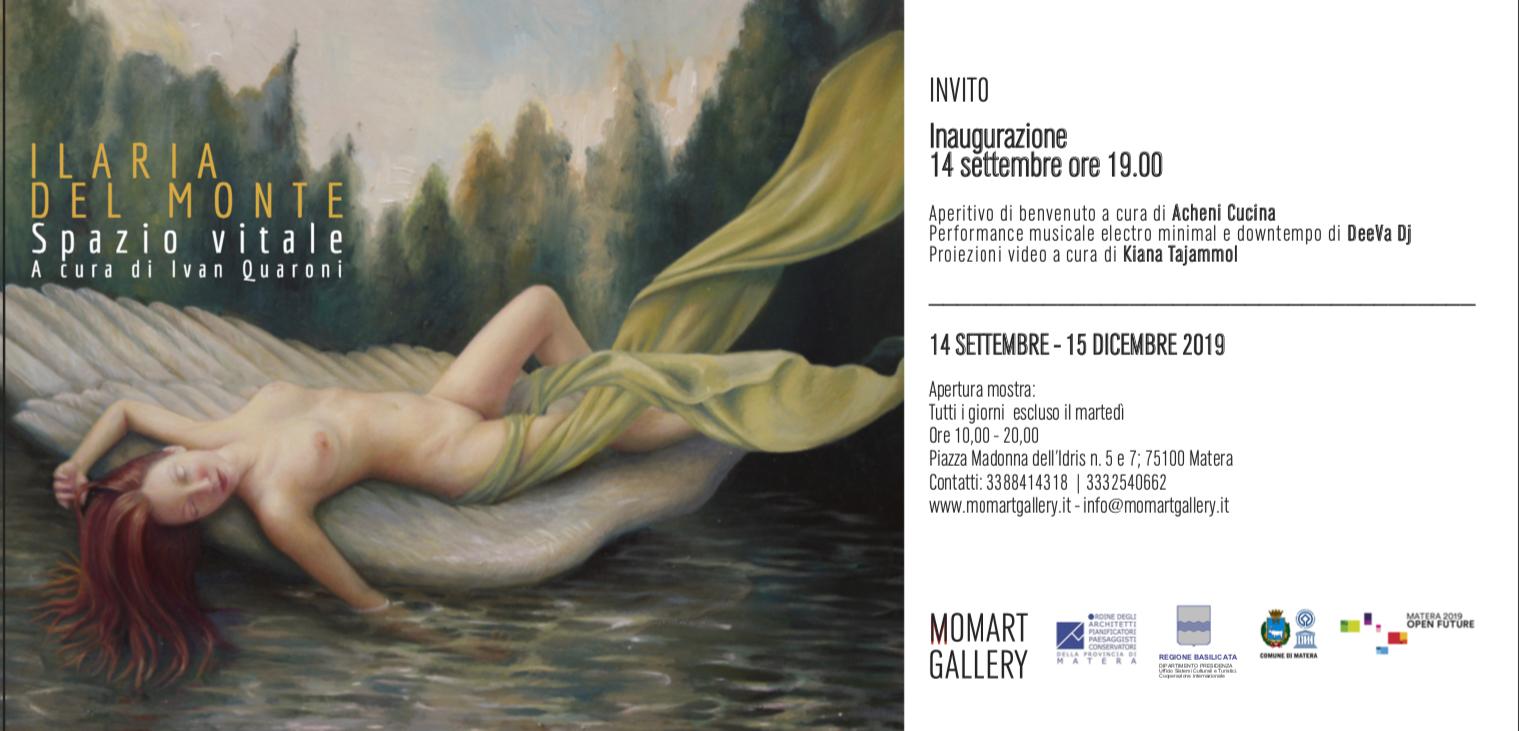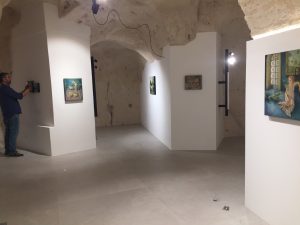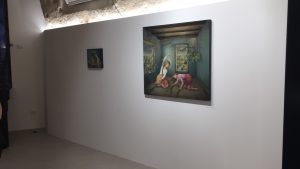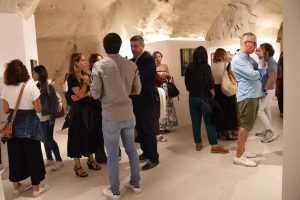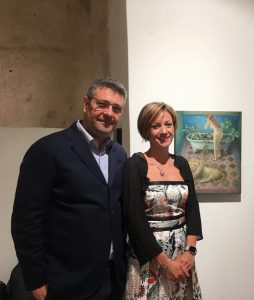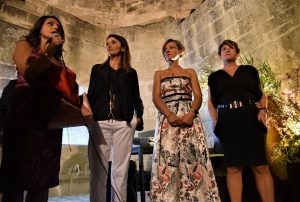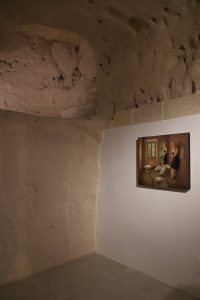SPAZIO VITALE
A cura di Ivan Quaroni – Momart gallery – Matera
Spazio vitale
By Ivan Quaroni
What Ilaria Del Monte paints about is not real but realistic. She aims for iconographic creations of psychic events, sculptural representations of intangible phenomena which plunge their roots into the imagination of the artist and her emotional experience.
The process of creating her pictorial universe is, in fact, similar to that of surrealists such as René Magritte and Paul Delvaux, who were influenced by De Chirico’s Metaphysics, and therefore more inclined to represent the enigmatic essence of existence using a mimetical and illusionistic technique. One aspect which art critics have pressed upon is the similarity of Ilaria Del Monte’s paintings
to the figurative expressions of the Novecento style, from Italian Magic Realism to German New Objectivity,
characterised by the vision of everyday lives suffused in mystery and speckled with subtle allusions and elusive connections. Actually there are other stylistic references, in addition to these, that underpin the artistic imaginary of Ilaria Del Monte (from Dalì to Balthus, to Rosa Loy and Neo Rauch). Then again, all painting is autophagous: in other words it feeds on himself, it draws on its own motifs, renewing them here and adapting them to the spirit of time there. What is more interesting than a mere critical interpretation of iconographic sources is an attempt to identify the original signature of her artwork, tracing its most profound
meanings by analyzing her pictorial work. Del Monte’s paintings are, first of all, retinal, capable of transforming the epiphany character of her visions into realistic language. Her images tell a vividly three-dimensional story of wonder and astonishment, through the creation of a universe of spectacular atmospheric
coherence, in which the ordinary and the fantastic melt seamlessly into each other.
Light, the cardinal element of narration, contributes to infusing every scene with a sense of indecipherable mystery. In fact, it is not full, zenithal daylight but vespertine twilight that the artist uses to recreate Heidegger’s Lichtung, a philosophical concept, comparable to the concept of chiaroscuro, which is used to indicate the coming to light of an entity from unrelenting darkness. Heidegger uses the metaphor of a clearing in the woods to assert that the truth is not something that comes out in bright daylight (because blinding light flattens out all differences) but something that you can discern in a subtle play of light and dark.
At the centre of Ilaria Del Monte’s vision, inthe suffused balance of light and shadow, the female figure stands out, a sort of modern version of the enraptured Victorian heroine, intent on celebrating mysterious
magical rituals and dark propitiatory rites. The stage for these apparitions is the home, the hearth, at the same time a box with uncertain perspectives and scenery flat, into which the entire surreal imaginary of the artist collapses, compressing itself. It is a cloistered place, strangely permeable to germination and natural inflorescence, a space of rhizomatic grafts and savage incursions, which render the boundary between the genres of landscape and the bourgeoisie interior transient. In this liminal, mediumistic dimension,
Ilaria Del Monte’s Stimmung unfolds, that unique, placidly melancholic mood, over which the Nietzchean epigraph of a well-known self-portrait by De Chirico – “Et quid amabo nisi quod aenigma est?” (And what shall I love, if not the enigma?) – appears to linger.
Enigmatic and arcane are indeed qualitiesthat her artwork exudes, art that concentrates on the mimetical
transformation of a cosmos permeated by magical powers of suggestion and psychoanalytical moods, by symbolic objects and totemic presence. A cosmos, in which, as mentioned earlier, women are the protagonists, heroines in a process of self-determination, which has the semblance of an occult ceremony and, at the same time, a psychomagic battle for liberation. In fact, just like in Psychomagic by Alejandro Jodorowsky, Ilaria Del Monte’s women can free themselves from past traumas and family constraints only by carrying out a series of symbolic actions that will bring them into direct contact with their own true being.
The animals that often populate the artist’s canvases are the living incarnations of nature bursting through the walls of domestic life. The home, on the other hand, has always been an architectonic symbol of family ties, a metaphor for emotional security, which may however, turn into an emotional prison or a fortress of loneliness. Such paintings by Ilaria Del Monte are mostly bare houses with flaking walls
(Ascension, 2019), peeling wallpaper (Il giorno di Leda, 2013), and cracked bricks (I pensieri sovrani, 2016). They are abandoned places overrun by vegetation (Il tempo che si attende, 2017), swamped in
sand (Casa dorata, 2016) or rent open by the tectonic power of rocks (La vita nel petto, 2016). And yet they hold on to the signs of an ancient splendour which is still visible in the precious floor decorations and in the boiserie (Il bagno, 2019), in the damasks of the upholstery (La piccolastanza, 2019), in the colourful parquet flooring (The Promise, 2019), and in the marble, the wood and the golden picture frames.
They are rooms which are almost alive, closing in on figures that recite a silentbook of spells; they are tentacled rooms which envelop and bind bodies in silky ties; walls that close in, like in a death trap, squeezing every breath of life, frustrating any possibility of success. Ilaria Del Monte’s women take a stand, pronouncing a mute liturgy of enchantments, enacting complex apotropaic choreographies and lastly invoking primigenial powers of liberation. Nature responds, breaking down the cloistered barrier: it is a lion or a swan, an alligator or a crow, it is climbing ivy and blood rose, it is the water lily.
In the artist’s paintings the house is a physical extension of the domain of our interior battle, the battlefield for the conquering of a vital space, which, in the end, takes on the guise of an Arcadian dream, lit up by a symbolist twilight. This is the case in Waiting for Ermes (2019), the definitive epilogue of every conflict: a “picture to dream over”, to use a definition dear to Arnold Böcklin, with the ideal representation of a classical landscape
Spazio vitale
By Ivan Quaroni
What Ilaria Del Monte paints about is not real but realistic. She aims for iconographic creations of psychic events, sculptural representations of intangible phenomena which plunge their roots into the imagination of the artist and her emotional experience.
The process of creating her pictorial universe is, in fact, similar to that of surrealists such as René Magritte and Paul Delvaux, who were influenced by De Chirico’s Metaphysics, and therefore more inclined to represent the enigmatic essence of existence using a mimetical and illusionistic technique. One aspect which art critics have pressed upon is the similarity of Ilaria Del Monte’s paintings
to the figurative expressions of the Novecento style, from Italian Magic Realism to German New Objectivity,
characterised by the vision of everyday lives suffused in mystery and speckled with subtle allusions and elusive connections. Actually there are other stylistic references, in addition to these, that underpin the artistic imaginary of Ilaria Del Monte (from Dalì to Balthus, to Rosa Loy and Neo Rauch). Then again, all painting is autophagous: in other words it feeds on himself, it draws on its own motifs, renewing them here and adapting them to the spirit of time there. What is more interesting than a mere critical interpretation of iconographic sources is an attempt to identify the original signature of her artwork, tracing its most profound
meanings by analyzing her pictorial work. Del Monte’s paintings are, first of all, retinal, capable of transforming the epiphany character of her visions into realistic language. Her images tell a vividly three-dimensional story of wonder and astonishment, through the creation of a universe of spectacular atmospheric
coherence, in which the ordinary and the fantastic melt seamlessly into each other.
Light, the cardinal element of narration, contributes to infusing every scene with a sense of indecipherable mystery. In fact, it is not full, zenithal daylight but vespertine twilight that the artist uses to recreate Heidegger’s Lichtung, a philosophical concept, comparable to the concept of chiaroscuro, which is used to indicate the coming to light of an entity from unrelenting darkness. Heidegger uses the metaphor of a clearing in the woods to assert that the truth is not something that comes out in bright daylight (because blinding light flattens out all differences) but something that you can discern in a subtle play of light and dark.
At the centre of Ilaria Del Monte’s vision, inthe suffused balance of light and shadow, the female figure stands out, a sort of modern version of the enraptured Victorian heroine, intent on celebrating mysterious
magical rituals and dark propitiatory rites. The stage for these apparitions is the home, the hearth, at the same time a box with uncertain perspectives and scenery flat, into which the entire surreal imaginary of the artist collapses, compressing itself. It is a cloistered place, strangely permeable to germination and natural inflorescence, a space of rhizomatic grafts and savage incursions, which render the boundary between the genres of landscape and the bourgeoisie interior transient. In this liminal, mediumistic dimension,
Ilaria Del Monte’s Stimmung unfolds, that unique, placidly melancholic mood, over which the Nietzchean epigraph of a well-known self-portrait by De Chirico – “Et quid amabo nisi quod aenigma est?” (And what shall I love, if not the enigma?) – appears to linger.
Enigmatic and arcane are indeed qualitiesthat her artwork exudes, art that concentrates on the mimetical
transformation of a cosmos permeated by magical powers of suggestion and psychoanalytical moods, by symbolic objects and totemic presence. A cosmos, in which, as mentioned earlier, women are the protagonists, heroines in a process of self-determination, which has the semblance of an occult ceremony and, at the same time, a psychomagic battle for liberation. In fact, just like in Psychomagic by Alejandro Jodorowsky, Ilaria Del Monte’s women can free themselves from past traumas and family constraints only by carrying out a series of symbolic actions that will bring them into direct contact with their own true being.
The animals that often populate the artist’s canvases are the living incarnations of nature bursting through the walls of domestic life. The home, on the other hand, has always been an architectonic symbol of family ties, a metaphor for emotional security, which may however, turn into an emotional prison or a fortress of loneliness. Such paintings by Ilaria Del Monte are mostly bare houses with flaking walls
(Ascension, 2019), peeling wallpaper (Il giorno di Leda, 2013), and cracked bricks (I pensieri sovrani, 2016). They are abandoned places overrun by vegetation (Il tempo che si attende, 2017), swamped in
sand (Casa dorata, 2016) or rent open by the tectonic power of rocks (La vita nel petto, 2016). And yet they hold on to the signs of an ancient splendour which is still visible in the precious floor decorations and in the boiserie (Il bagno, 2019), in the damasks of the upholstery (La piccolastanza, 2019), in the colourful parquet flooring (The Promise, 2019), and in the marble, the wood and the golden picture frames.
They are rooms which are almost alive, closing in on figures that recite a silentbook of spells; they are tentacled rooms which envelop and bind bodies in silky ties; walls that close in, like in a death trap, squeezing every breath of life, frustrating any possibility of success. Ilaria Del Monte’s women take a stand, pronouncing a mute liturgy of enchantments, enacting complex apotropaic choreographies and lastly invoking primigenial powers of liberation. Nature responds, breaking down the cloistered barrier: it is a lion or a swan, an alligator or a crow, it is climbing ivy and blood rose, it is the water lily.
In the artist’s paintings the house is a physical extension of the domain of our interior battle, the battlefield for the conquering of a vital space, which, in the end, takes on the guise of an Arcadian dream, lit up by a symbolist twilight. This is the case in Waiting for Ermes (2019), the definitive epilogue of every conflict: a “picture to dream over”, to use a definition dear to Arnold Böcklin, with the ideal representation of a classical landscape

